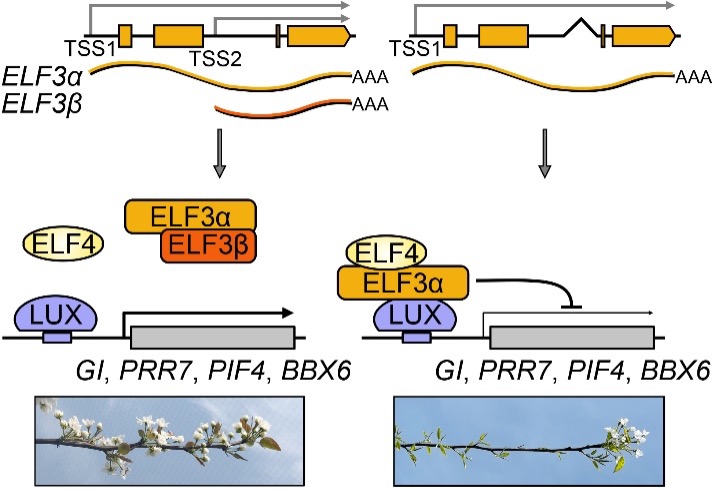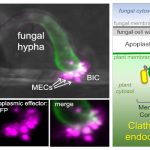Two isoforms of ELF3 antagonistically regulate flowering
By Peng Wang1,2, Yu Li1,2, Zhe Liu1,3, Xuhan Li1, Shaoling Zhang1,2, Juyou Wu1,2,4
1Sanya Institute of Nanjing Agricultural University, National Key Laboratory of Crop Genetics & Germplasm Enhancement and Utilization, Nanjing Agricultural University, Nanjing, 210095, China
2College of Horticulture, Nanjing Agricultural University, Nanjing, 210095, China
3Department of Pharmacy, Changzhi Medical College, Changzhi, 046000, China
4Jiangsu Key Laboratory for Horticultural Crop Genetic Improvement, Nanjing, 210014, China
Background: Flowering is critical for sexual reproduction and fruit production. The circadian clock regulator EARLY FLOWERING3 (ELF3) serves as a scaffold protein in the evening complex that controls flowering. EARLY FLOWERING4 (ELF4) and the transcription factor LUX ARRHYTHMO (LUX) directly bind to ELF3 to form the evening complex (EC) that gates circadian clock–mediated physiological responses in multiple species. Alternative promoter usage has been identified as a critical response to environmental signals in thousands of genes. However, the function of alternative promoter usage in flowering time regulation, particularly in relation to ELF3 function, remains poorly understood.
Question: How does alternative promoter usage at the ELF3 locus regulate flowering?
Findings: Here we report that alternative promoter usage generates two transcript isoforms from the ELF3 locus. This phenomenon is conserved among plants such as Arabidopsis (Arabidopsis thaliana), soybean (Glycine max), tomato (Solanum lycopersicum), apple (Malus × domestica), and pear (Pyrus sp,). Our results indicate that the full-length transcript ELF3α and the shorter transcript ELF3β antagonistically regulate flower induction. The 2nd intron of the ELF3 locus is critical for ELF3β expression. We determined that the AtELF3β transcript isoform encodes a protein that promotes flowering by competitively binding to AtELF3α and thereby disrupting EC complex formation. Our findings thus establish a mechanism for fine-tuning flower induction that depends on manipulating transcript isoforms through alternative promoter usage.

Next steps: In further studies, we will investigate the detailed mechanisms by which the second intron regulates ELF3β expression and how ELF3β expression responds to the environment.
Reference:
Peng Wang, Yu Li, Zhe Liu, Xuhan Li, Yicheng Wang, Weijuan Liu, Xiao Li, Jianjian Hu, Wenyi Zhu, Changquan Wang, Shan Li, Tingting Gu, Dongqing Xu, Chao Tang, Yingtao Wang, Chao Li, Shaoling Zhang, Juyou Wu. (2023). Reciprocal regulation of flower induction by ELF3α and ELF3β generated via alternative promoter usage. https://doi.org/10.1093/plcell/koad067
ELF3的选择性转录调控花芽分化
最近 Wang et al.在The Plant Cell在线发表了题为Reciprocal regulation of flower induction by ELF3α and ELF3β generated via alternative promoter usage的研究论文,揭示了ELF3基因的选择性转录调控花芽分化的分子机制。
- 背景回顾
开花是植物有性生殖的重要过程,也是果树生产的关键环节。生物钟调控因子EARLY FLOWERING3(ELF3)作为Evening Complex的重要组分,参与花芽分化调控。EARLY FLOWERING4(ELF4)和转录因子LUX ARRHYTHMO(LUX)直接与ELF3结合形成Evening Complex,在多个物种中调控昼夜节律介导的生理反应。虽已发现多种环境信号影响可变启动子的选择性转录,但ELF3选择性转录及其在调控花芽分化中的作用尚不明确。
- 科学问题
ELF3基因的可变启动子如何调节花芽分化?
- 研究发现
本研究发现ELF3基因具有可变启动的特性,能够编码ELF3α和ELF3β两种蛋白。ELF3β与ELF3α结合形成聚合体后,抑制ELF3α-LUX转录调控复合体的功能,进而调控花芽分化。同时,在苹果、大豆、番茄和拟南芥等物种中也鉴定到ELF3β转录本,表明ELF3基因的可变启动调控机制可能广泛存在于在植物界。研究结果进一步丰富了对梨花芽分化分子调控机制的认知,为梨育种提供了可靠的分子标记。
- 展望未来
在进一步的研究中,我们将探究ELF3基因的第二个内含子调控ELF3β表达的机制,解析ELF3β响应环境变化的调控网络。



